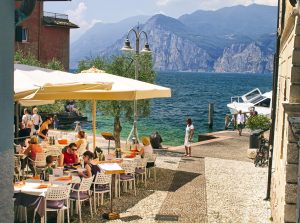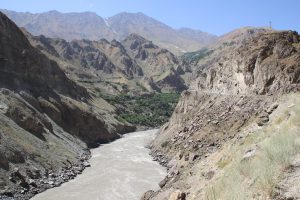Involving Central Asia in Afghanistan’s future – what can Europe do?

Introduction
EU policy on Central Asia is unclear about the relationship between Afghanistan and Central Asia. The June 2010 Joint EU Council and Commission Implementation Report of the EU Strategy for Central Asia argues that cooperation in the area of security is of growing importance in EU-Central Asia relations, especially in light of developments in Afghanistan over the past few years. Even if security is among the Strategy’s seven key areas of engagement, the arguments put forward are vague: the Implementation Report states that “Afghanistan is a security issue of particular common concern and there is scope for more focused dialogue and cooperation between Central Asian countries and the EU”; and “there is a need to integrate the growing link between Central Asia and the wider region into EU- Central Asian cooperation.”(1)
The Central Asia-Afghanistan relationship is therefore evoked only to recall that the states of Central Asia are directly threatened by the insecurity emanating from Afghanistan. Border security programmes are given priority, while the language on “the prevention of extremism and counter-terrorism cooperation” does not really give a clear idea how Europe can pragmatically interact with Central Asian governments and societies on the matter of Afghanistan. Given the importance of the Afghan question, it would be beneficial if Europe could make more daring and concrete proposals.
The progressive departure of ISAF troops – including 10,000 American soldiers in 2011, and 20,000 in 2012 – and the risk generated by the security vacuum which will follow(2) must be the occasion for more clear-cut EU involvement: how can the states of Central Asia be helped both to deal with the security challenges with which they will be faced in 2014 and beyond, and to build a constructive relationship with Kabul? The Central Asian regimes, which tried to bargain with the West over their involvement in the Northern Distribution Network, now probably realise that they are the first ones to need a stable Afghanistan, and that the complete departure of the international coalition will not only be a challenge for their geopolitical environment, but for their domestic stability.
This paper addresses the issue of involving the Central Asian states in a more constructive relationship with Afghanistan. First, the limitations of the current EU involvement with border security, and the impact of the transit value of the region on the Central Asia-Afghanistan relationship is discussed. After a brief overview of Central Asia’s current engagement with Afghanistan the paper turns to ways the EU can further foster economic cooperation, participation in building a regional cooperation architecture and people-to-people exchanges.
Border security is not enough
In European programmes, the concretisation of Central Asia- Afghanistan relations appears foremost in the approach to border security. The three bordering states (Tajikistan, Turkmenistan and Uzbekistan) together with Kazakhstan and Kyrgyzstan participate in the BOMCA programme (Border Management in Central Asia) and CADAP (Central Asia Drug Action Programme), to which more than €45 million has been committed so far, as well as in the training of border guards by the OSCE.(3) Some joint projects with Afghanistan, like BOMBAF and the OSCE-led Tajik-Afghan and Turkmen-Afghan border security training, have also been organised. The Central Asia Border Security Initiative (CABSI), a platform for dialogue and discussion initiated by the Austrian Federal Ministry of the Interior with support from the European Union, at regular intervals meets members of the international donor community and agencies involved in border security technical assistance, such as the UNDP, OSCE, UNODC, IOM, Japan, the Russian Federation and the U.S.(4)
The fight against drug trafficking is also an important component of the EU and member states’ engagement. The Central Asia Regional Information and Coordination Centre (CARICC) for combating the illicit trafficking of narcotics, psychotropic substances and their precursors has become operational and it plans to establish links with Interpol. The UN Preventive Diplomacy Centre based in Ashgabat, dealing with the implementation of the four pillars of the UN Global Counter- Terrorism Strategy in Central Asia, also presents an opportunity for cooperation.(5) However, due to a lack of independent evaluation it is unclear if the ongoing programmes have a positive impact and whether they are sustainable. Anonymous interviews done with OSCE officers were pessimistic.
Strengthening border security is not enough. First, the idea that radical Islamic movements can be stopped by better monitoring the borders with Afghanistan seems to ignore the fact that such groups develop predominantly in a local context. They are founded on domestic issues in which the Afghan Taliban plays only a minor role. Second, stopping drug trafficking is not solely a question of border control, but of the struggle against corruption. The drugs which circulate through underground criminal groups are not being stopped: Western pundits usually agree that a large part of the trafficking is done by people with ties to Central Asian law enforcement agencies. The real battle is therefore against the corruption of these agencies and, more globally, of state structures, and not only against drugs crossing borders illegally. Moreover, the prevention of rising drug use in Central Asia itself is limited by the state practice of criminalising users. The EU focus on border security is therefore important, but far from efficient, since it cannot thwart challenges which depend on the Central Asian social fabric and the willingness of Central Asian regimes to engage in reform.
The transit value of Central Asia. What next?
Central Asia is reinforced as a transit zone to Afghanistan through its growing role in the Northern Distribution Network (NDN). In 2010 it supplied about 35 per cent of all ISAF cargo headed for Afghanistan, a figure which will probably reach 75 per cent by the end of 2011(6) in order for ISAF to reduce its dependency on the Pakistan Ground Line of Communication. This NDN presents two issues in terms of the EU’s construal of the Central Asia-Afghanistan relationship. First, the Central Asian states, and in particular the Uzbek government, believe that they should be rewarded in political terms for “services” rendered to ISAF. This, of course, is a complete reversal of priorities and should, as an argument, be refuted by U.S. and EU negotiators. As an important chance to stabilise Afghani- stan, the NDN is above all an opportunity for the Central Asians themselves. Because NATO and the Pentagon were the main negotiators with the Central Asian governments about NDN – though Germany negotiates directly with Uzbekistan concern- ing its base in Termez – the EU’s involvement was marginal. Its broader call for political reform as a key element to avoid destabilisation coming from Afghanistan went largely unheard and seemed out of touch with European security interests on the NDN that were largely transmitted through other actors.
Second, American policy implied that the NDN would contrib- ute to Central Asian regional development thanks to improve- ments in the railway network and as an initiative of regional character.(7) However, this is a questionable assertion: while Uz- bekistan benefited from the development of its road network and pocketed a non-negligible amount of transit rights fees, in 2010 it maintained a railway blockade against Tajikistan which contributed to the inflation of the price of basic goods there. No regional cooperation really emerged on the transit question, instead the zone’s role as a transport corridor is developing through strategies originating in China, not via the NDN. The latter could even be responsible for inhibiting regional trade: a freight tariff increase made by the Uzbek government has placed Central Asian companies in a difficult situation, as they are unable to pass on the price increase. What will the NDN’s legacy be once ISAF has departed? Will the transit value of Central Asia only have served the international community in its action in Afghanistan or will it constitute a positive element in Central Asian economic development?
Fostering Central Asian economic presence in Afghanistan
The states of Central Asia are much more than transit sites, whether for non-lethal material bound for ISAF, or, in the opposite direction, for Afghan opium headed for Russia and Europe. The three border states of Tajikistan, Turkmenistan and Uzbekistan, as well as Kazakhstan, all play non-negligible roles in providing economic and reconstruction aid, in particular to the northern regions of Afghanistan. In the provinces of Herat, Badghis, Faryab, Jowzjan, Balkh, Kunduz and Badakhshan, Afghans live a life oriented towards their northern neighbours. The economic and political aid supplied to the Tajiks, Turkmens and Uzbeks of Afghanistan traditionally originated from the north although today international donors play the most substantial role in assistance in these provinces.
Turkmenistan is an important partner for the Afghan border regions, especially in the electricity sector. Ashgabat constructed power stations and electric lines in the Balkh region, and hopes to increase fivefold its export of electricity to Afghanistan thanks to the Asian Development Bank’s (ADB) investment in two new electric lines.(8)
The Tajik authorities have created free economic zones along their border with Afghanistan, which enables border populations to set up small trade mechanisms to help lift them out of poverty. In 2008, a Power Purchase Agreement was signed between both states for the annual export of 300 megawatts of Tajik electricity, but at present exports are still very limited.(9) Feasibility studies for a new electricity line from the Sangtuda 1 and 2 power stations to Pul i-Khumri via Kunduz and Balgan are under way, financed by the ADB among others as part of the Central Asia-South Asia Regional Electricity Market (CASAREM) project.(10) However, the severe electricity crisis in Tajikistan hampers the prospect of exports. For the moment, the controversial Rogun hydroelectric project is blocked by Uzbek refusal and the absence of credible financing, whereas the Tajik government refuses to prioritise smaller scale power stations.
Uzbekistan is also active. It restored Soviet-era power supply to Afghanistan at the beginning of 2002. Since 2009, it has delivered as much as 150 megawatts to Kabul thanks to the construction of a line, with ADB funds, of more than 400 kilometres stretching from Hairaton to Pul i-Khumri and then to the Afghan capital. This figure should eventually increase to 300 megawatts. Upon the request of the Afghan government, Uzbekistan also constructed bridges between the cities of Mazar e-Sharif and Kabul. The Uzbek national railway company, Ozbekistan Temir Yollari, has won an ADB tender to build a new 75-kilometre long line between Hairaton and Mazar e-Sharif. The line is planned to be operational by the second half of 2011. Uzbekistan is also supplying fuel, construction materials, metal-roll, fertilisers and wheat to Afghanistan.(11)
Kazakhstan, despite sharing no borders with Afghanistan, also presents itself as a substantial economic partner. It is the only Central Asian country which has an Assistance Programme for the Reconstruction of Afghanistan that includes projects related to water supply, infrastructure development, delivery of cement and construction commodities.(12) In addition, Kazakhstan has positioned itself as a pivotal actor in Afghanistan’s wheat market: 15 per cent of Afghan wheat and flour imports came from Kazakhstan in 2007 (20 per cent from Uzbekistan, 50 per cent from Pakistan).(13) Due to the poor Russian and Pakistani harvests, caused by forest fires and flooding, the Kazakh share in the market has grown: in 2010 Afghanistan’s 700,000 ton wheat deficit was mostly met by Kazakhstan.(14)
How can the EU contribute to promoting these and other Central Asian efforts? Among many issues, three components seem central to success: electricity supplies (connected to water management), food security and small trade.
Central Asia’s role in the supply of electricity to Afghanistan, vital for the latter, might contribute to developing water management/ energy cooperation in Central Asia. The need for collective water management cannot ignore Afghanistan, which shares with its neighbours the cross-border Amu Darya River, and whose increasing water needs will have an upstream impact. Water supply reforms and sanitation policy are strategic for the two regions. The inclusion of Afghanistan in the regional water dialogue and gradually also in cooperation structures would therefore be a logical step to take for the EU. On environmental matters – another focal sector for EU aid – both Central Asia and Afghanistan are regions where the negative impact of climate change is potentially catastrophic. The EU Water Initiative and the new EU-Central Asia Working Group on Environmental Governance and Climate Change should therefore incorporate Afghanistan, as the challenges to be met are largely similar.
Kazakhstan’s growing role as a grain producing power, and its influence on the food security of its Kyrgyz, Tajik, Uzbek, Turkmen and Afghan neighbours might become a driver for broader discussions about food security. Such discussions will involve not only a reflection on the priority given to cotton, but also on land ownership reforms, the importance of small bank loans to farmers, logistical improvements (transport and food storage), and the development of local agribusiness to gain more independence from rising world prices. EU member states and national agencies for development have a lot of expertise to offer on these matters and some have developed programmes which could be extended by taking into account the regional character of these issues.
Finally, the small private sector may play an important role in restoring economic growth and offering employment both in Central Asia and Afghanistan. Mid-scale economic projects, such as providing support to cereal-export companies or construction material firms, could be promoted, for instance as part of the Central Asia Invest (CAI) programmes or the Small and Medium-sized Enterprises (SMEs). Of course the Central Asian legal context, in particular in Uzbekistan, is not favourable to SMEs, although this has improved in Kazakhstan. The EU also supports the Business Intermediary Organisations (BIOs) programmes, such as chambers of commerce, sector-specific trade, industrial and professional associations. On this issue, the Aga-Kahn Foundation has already played an important role in fostering Afghan and Tajik cross-border small businesses. The EU-OECD joint “Eurasia Competitiveness Programme – Central Asia Initiative” already includes all five Central Asian countries as well as Afghanistan and Mongolia.
Engaging Central Asia as part of a broader Regional Security Architecture
CentralAsia should also be incorporated in long-term approaches to Afghan regional security. In the years and decades to come, with the progressive withdrawal of ISAF forces, the regional character of the “Afghan question” will become more acute, to the detriment of its international character. The neighbouring regional players, which already have a key role in the Afghan domestic situation, will enjoy more and more autonomy and be in a position to exercise greater leverage over it. The Central Asian states will therefore become involved in the exercise of regional cooperation and competition between the main actors – Pakistan, India and Iran – and to a lesser extent Russia and China. As far as the United States and the EU are concerned, they will need to learn to delegate their responsibilities to some of their regional allies. Through the positioning of each country vis-à-vis Afghanistan a new regional order will be created. The EU has every interest both in assuring that the Central Asian states have a say in the future of Afghanistan, and that they both share a similar view on the desired outcome, i.e. a stable, unified and secular Afghanistan. The EU should, where possible, include Central Asia in mediation activities in Afghanistan.
Turkmenistan, which possesses a positive neutrality status, and which, in the 1990s, was the only country in the region to have relatively good relations with the Taliban, has recently proposed holding inter-Afghan peace talks in Ashgabat under the aegis of the United Nations. Given the weakness of Turkmen diplomacy and its isolationism, this proposition seems rather unrealistic, but it reveals a genuine interest in playing a positive role. The Tajiks have put forward proposals concerning the implementation of peace-building mechanisms at the regional level. Afghanistan has a lot to learn from Tajikistan’s experience of ending its civil war of the 1990s, in particular the proposition that political negotiations between the authorities and the insurgency must be held at the local level, province by province, each time taking the local balance of power into account, prior to being discussed at the national level.(15) Lastly, Tashkent proposed to revive the idea of a regional mechanism to frame the negotiations between the Afghan parties, and maintained that the solution to Afghan problems can only be solved at a regional level.(16) But the proposal has not received great international attention: while the U.S. is not interested in creating a mechanism where Moscow, Beijing, and especially Tehran, would be able to discuss a solution to the Afghan crisis with Western powers.
It is partially up to the EU – whose logics of engagement in Afghanistan have always pertained more to reconstructing a country that had been at war than to the U.S.-style “war on terror” – to propose regional mechanisms in which Afghanistan’s neighbours will have platforms for collective discussion. When choosing regional allies, the states of Central Asia ought to be increasingly included, even if their economic weight is limited, their regimes authoritarian, and despite the support they give to their co-ethnics. After all they are relatively free of any distinct political agenda for Afghanistan, which is not the case with Pakistan or Iran. Paying closer attention to the Central Asian viewpoint on peace-keeping mechanisms could also make good use of their knowledge on Afghanistan, and therefore strengthen European involvement.
People-to-people relations between Central Asia and Afghanistan
Due to their Soviet legacy, the Central Asian states in terms of schooling and public health seem to the Afghans like developed countries. Decades of Soviet-Afghan proximity have also legitimated cultural exchanges. Turkmenistan, for instance, offers some financial and technical assistance to the Turkmen minorities in Afghanistan, in the form of medical expertise, as well as various state-funded scholarships. Although not a bordering state and despite not having any co-ethnics in Afghanistan, Kazakhstan is the state that has stepped up as a driver of this type of regional cooperation. During its presidency of the OSCE, Astana announced the implementation of a $50 million programme to school 1,000 Afghan students between 2010 and 2014 in such specialties as healthcare, agriculture, police, border control, engineering, teaching and education. In this educational and medical domain, the states of Central Asia for once find themselves in the position of being donors and not recipients, and their strategies could be more directly supported by Europe. Even if small-scale, these initiatives show that there is room for manoeuvre on this issue.
Education, science and people-to-people activities, all key aspects of European programmes, offer a potentially large spectrum for cooperation between Central Asia and Afghanistan. Europe’s visibility in terms of culture and education is particularly high in both regions. Afghan intellectual milieus have been largely educated in the Soviet mould and their mastery of Russian would facilitate their integration into European networks via Central Asia, or indeed via Russia. Developing the role of the Central Asian states in the training of some Afghan specialists, for instance in medicine or in some technical fields, would enhance the modest progress currently made in Central Asian higher education. Even if education and science in Central Asia have encountered huge difficulties since the collapse of the Soviet Union – foremost lacking resources and restrictive policies – they can still provide a positive framework for those Afghans who cannot afford to go to Europe or to India, another important partner for Afghanistan in terms of educational programmes. The region hosts a few international universities which could teach Afghan students financed through European programmes. Central Asia could also be encouraged to foster a better gender balance in Afghan higher education, as young Afghan women might be more likely to be granted permission by their families to leave for countries of Muslim tradition, deemed culturally closer to them than Europe. Though the authoritarian regimes of Central Asia are unable to serve as a political model for Afghanistan, the EU could promote exchanges in the domain of education, science and people-to-people relations.
Conclusion
At stake is the stability of Central Asia. The unfavourable geopolitical context could deal a fatal blow to the states that are most susceptible to the destabilising effects from Afghanistan, namely Tajikistan, Uzbekistan and Kyrgyzstan. However, the EU cannot limit its involvement in the Central Asia-Afghanistan relationship to border security and the transit issue. It needs to be more innovative by supporting already existing programmes and instruments involving energy supplies, food security, water management, small-scale investments, people-to-people exchanges, and participation in building a new framework for regional security of which Central Asian states should be an active part. The “Afghan question” must be a motivation for the EU to ask for more reforms in Central Asia. EU activities aimed at securing Central Asia from the possibility of further Afghan destabilisation should go hand in hand with a push for domestic change. There is little time remaining before 2014 for the EU to contribute both to shaping a political solution for Afghanistan, and to strengthening Central Asian societies.
- Joint Progress Report on the Implementation of the EU Strategy for Central Asia (Brussels, 28 June 2010), p. 27, http://register.consilium.europa.eu/pdf/en/10/st11/st 11402.en10.pdf#page=2.
- G. Dorronsoro, “Afghanistan: The Impossible Transition”, Carnegie Paper, June 2011.
- High Representative/Vice-President Ashton on behalf of the Commission, European Parliament, 19 November 2010, http://www.europarl.europa.eu/sides/ getAllAnswers.do?reference=E-2010-8381&language=EN.
- “Press Release: Central Asian Border Security Issues Discussed in Dushanbe”, BOMCA, 17 March 2011, http://www.bomca.eu/en/news/8.html.
- Joint Progress Report on the Implementation of the EU Central Asia Strategy (Brussels, 28 June 2010).
- Joshua Kucera, “Child Labor and U.S. Military Cooperation in Uzbekistan”, Eurasianet.org, 5 May 2011, http://www.eurasianet.org/taxonomy/term/2325.
- A. Kuchins, T. Sanderson, D. Gordon, The Northern Distribution Network and the Modern Silk Road (Washington DC: CSIS, December 2009).
- “Turkmenistan and Afghanistan”, Institute for the Study of War, http://www. understandingwar.org/themenode/turkmenistan-and-afghanistan.
- Import of Power from Uzbekistan, Tajikistan, and Turkmenistan, Afghanistan Infrastructure and Rehabilitation Programme, https://www.irp-af.com/?pname=ope n&id=291&type=html&c=5.
- “Afganistan pristupil k stroitel’stvu LEP dlia tranzita elektroenergii iz Tadzhikistan”, TopTJ, 15 February 2010, http://www.toptj.com/ShowNews.aspx?news_ id=ACEA11C0-34D1-4D4B-84ED-78DE9FD56819.
- Shoislam Akmalov, “Uzbekistan’s Role in Stability and Development”, Policy Perspectives, vol. 6, no. 1, 2009, http://www.ips.org.pk/aboutips/1048.html.
- “Commitment to Assist Afghanistan”, Kazakhstan Embassy in the United States, http://www.kazakhembus.com/index.php?page=commitment-to-assist-afghanistan.
- Regional Food Outlook, South Asia, Appendix 1: Afghanistan (Washington DC: The World Bank, 2010), p. 79, http://siteresources.worldbank.org/SOUTHASIAEXT/
Resources/223546-1269620455636/6907265-1287693474030/AFG_Regional_ Food_Prices.pdf. - Food Security Outlook Update (March 2011), http://reliefweb.int/sites/reliefweb.int/ files/reliefweb_pdf/node-396755.pdf.
- Interviews with Tajik experts on Afghanistan, Dushanbe, June 2010.
- Uzbekistan has referred to the 6+2 initiative – the six countries bordering Afghanistan plus Russia and the U.S. – which initiated negotiations between the Northern Alliance and the Taliban between 1999 and 2001. With the addition of NATO, the mechanism would become a 6+3.



![shutterstock_1240181551 [Omgezet]](https://eucentralasia.eu/wp-content/uploads/2024/10/shutterstock_1240181551-Omgezet-300x248.jpg)



